Visiting in Spring Overview
Learn About Visiting Olympic National Park in the Spring Time
After a long, wet, sunless winter in the Olympic Peninsula, spring greets you with an abundance of waterfalls, wildlife, wildflowers, and warmer weather. The park is teeming with life—wildlife frolicking with their young, whales beginning their migration, and a lush, green landscape—creating a refreshing and magical feel to this already extraordinary region. There are many benefits to visiting Olympic National Park in the spring, as well as some drawbacks. In this guide, we will go into detail about what to expect when visiting in March, April, or May.
BENEFITS OF VISITING IN SPRING

There are many benefits of visiting Olympic National Park in the spring. First, the wildlife is spectacular: The Roosevelt elk are giving birth to their young in the Hoh and Quinault Rainforests; and it is especially wonderful to watch wildlife in the river valley, where they eat the early spring vegetation. As spring migration begins in May, birdwatching is a very popular activity in Olympic National Park. And, in addition, amphibians, snails, and banana slugs are commonly seen along the trail since the temperatures are rising and the humidity is still high. Second, waterfalls are cascading dramatically over cliffs. Many locals refer to the Olympic Peninsula as “the valley of 10,000 waterfalls”. There is a trail of waterfalls that will lead you to the most notable waterfalls in Olympic National Park. Some of the best waterfalls in Olympic include Sol Duc Falls, Falls Creek Falls, Madison Creek Falls, and Enchanted Valley. And, lastly, the crowds have yet to arrive in the spring, making the trails nearly empty. Although Olympic National Park is the seventh busiest park in the United States, most people visit the park from July through September. With less congestion, you are able to see the majority of the park without having to share it with a hundred other visitors.

DRAWBACKS OF VISITING IN SPRING
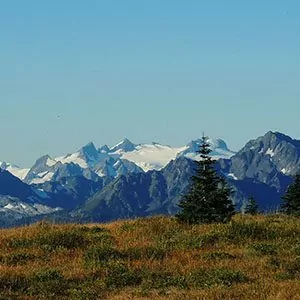
The biggest drawback to visiting Olympic National Park in the spring is the unpredictable weather. On average, there are 15-19 days of precipitation each month during the spring, and temperatures can vary drastically from the mountains to the coast. It is important to be prepared with extra layers when hiking, especially in the spring. Make sure you bring a long-sleeve layer, warm layer, and rain jacket with you on your hike. Another drawback of visiting Olympic NP in the spring is that not all of the trails may be open. It is not uncommon for the mountains to receive snowfall throughout the spring and into June. Trails to the subalpine may be snow-covered and even unpassable. Make sure you check the trail conditions before starting your hike.
CLIMATE AND TEMPERATURE IN SPRING
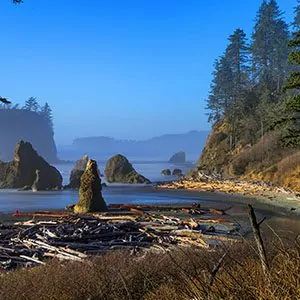
Although spring is when the climate begins to mellow and temperatures become warmer, the weather can be very unpredictable in the springtime. It is also important to note that each area in the park—the mountains, coast, and rainforest—can vary greatly. On any given day, the mountains to the coast can experience a 10° temperature difference. In the spring, when the weather is even more unpredictable and can change at a moment’s notice, it is very important to be prepared and know the day’s forecast. Check the current forecast for Hurricane Ridge, Quinault Rainforest, and Rialto Beach. Below are the average temperatures and days of precipitation for the three locations:
| Month | Hurricane Ridge | Quinault Rainforest | Rialto Beach | Days of Precip | |||
| Avg Hi | Avg Lo | Avg Hi | Avg Lo | Avg Hi | Avg Lo | ||
| March | 32°F (0°C) | 19°F (-7°C) | 51°F (10°C) | 36°F (2°C) | 51°F (10°C) | 38°F (3°C) | 19 Days |
| April | 37°F (2°C) | 21°F (-6°C) | 56°F (13°C) | 39°F (3°C) | 55°F (12°C) | 41°F (4°C) | 17 Days |
| May | 44°F (6°C) | 28°F (-2°C) | 63°F (17°C) | 44°F (6°C) | 61°F (16°C) | 45°F (6°C) | 13 Days |
THINGS TO DO IN SPRING
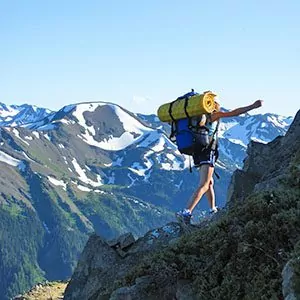
There are so many activities that you can do while in Olympic National Park. Whether you want to hit the trail on a day hike, hike through meadows of wildflowers, try your rod at a salmon in the Elwha Valley, or watch as thousands of whales migrate down the coast, there is something for everyone to enjoy in Olympic in the spring. Below are the most popular things to do in the spring:
Hiking: Some of the best hiking in Olympic National Park can be done in the spring. The trails at lower elevations are clear of snow and lush with new life after the winter’s rain, and the mountains may be dusted with snow, making them a picture-perfect background for your hike. As you hike in the Hurricane Ridge area, you can view the colorful wildflower displays starting as soon as the snow melts (read all about the best trails for wildflowers here). Spring is also the best time of year to hike to waterfalls, as they are gushing after a season of rain. There is more information below about the best trails to hike in the spring.
Backpacking: For a multiday adventure, backpacking in Olympic National Park is a great way to see areas of the park that you can only get to on foot. 95% of the park is Congressionally-designated wilderness, meaning that it will stay in its natural state and remain untrammeled by man. Because the majority of visitors have yet to arrive, it may be easier to obtain the backcountry permits you desire. Spring is a wonderful time to explore the backcountry because wildflowers are in peak bloom, waterfalls are flowing extravagantly and the wilderness is full of life.
Fishing: Spring is a great time of year to fish in the Olympic National Park. As the water warms, it makes the fish more aggressive and more likely to bite your bait. The best locations for fishing in the spring are Lake Crescent, Hoh River, and Queets River. Lake Crescent was isolated by landslides thousands of years ago, so there are two unique species of fish that have adapted to the high levels of nitrogen in the lake—Crescenti and Beardslee trout. In spring, the most common fish to catch in Lake Crescent are Rainbow trout, Cutthroat trout, and Kokanee salmon. The Hoh and Queets Rivers, which run through the rainforests in Olympic National Park, are spectacular in the spring since they receive so much rainfall in the winter. The most common fish to catch in the rivers are Winter steelhead. A Washington State fishing license is not required, however, a Washington State catch record card is required for catching steelhead and salmon.
Wildlife Viewing: Many species of mammals are giving birth during the spring. It is an extraordinary time to see Roosevelt elk cows and calves, and mountain goat nannies and kids. The best locations for viewing wildlife in the spring are in the lower valleys and rainforests. For a detailed list of the best locations to see the most popular animals in the park, click here.
Whale Watching: Each April through May, Gray whales migrate from Baja California to Alaska along the Olympic Coast. There are many spots where you can see the whale migration just standing on the coast. Some of the best places to watch the hundreds of whales pass by are Port Townsend, Port Angeles, Shi Shi Beach, Rialto Beach, and Kalaloch Beach. Check out the Whale Trail for an interactive map and more information.
HIKING IN OLYMPIC IN SPRING
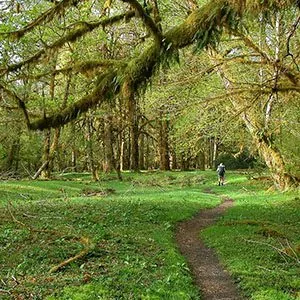
Spring is one of the best times of year for hiking in Olympic National Park. The rainforests are lush with dense ferns and mosses, and the canopy is so thick in the rainforests, that even when it rains, you have a natural cover. Below we have listed our four favorite hikes in the park, but you can check out a more comprehensive list here.
- Trailhead: Sol Duc River Trail
- Distance: 1.6 miles roundtrip
- Elevation Gain: 200 feet
Sol Duc Falls is one of the most popular waterfalls in Olympic National Park and for good reason. The trail starts off behind the Sol Duc Hot Springs Hotel, on a wide path, under the thick canopy of Sitka spruce and Douglas-fir, surrounded by epiphytes and nurse logs. This is a classic Olympic Peninsula rainforest hike with minimal elevation gain, making it perfect for all ages and levels of ability. At .8 miles, you will reach the falls, which can split into four channels, and fall 48 feet to the canyon below. This waterfall is at its peak in the spring, after all of the precipitation that the forest received in the winter.
2. FALLS CREEK FALLS
- Trailhead: Falls Creek Falls Trailhead
- Roundtrip Distance: 4 miles
- Elevation Gain: 100 feet
This trail takes you on a gentle grade to four waterfalls. The first waterfall is just a quarter mile after starting the trail, impressive as it cascades down a series of boulders. Continue on the path to an observation point at the base of the upper falls, as well as a view of the water pouring over the rocks to create the lower falls. As you continue on, the trail has a series of slight switchbacks that will take you to Falls Creek Falls. In spring, the falls are rushing with water, and the scenery is lush with green life. Spring is a truly fantastic time of year to visit Falls Creek Falls.
3. PONY BRIDGE
- Trailhead: East Fork of Quinault River
- Distance: 4.8 miles roundtrip
- Elevation Gain: 600 feet
This 5-mile hike through the Quinault Rainforest is called Enchanted Valley for a reason. The lush, fern-covered rainforest is green with life and wisdom, enchanting all who walk through. Hiking along the North Fork of the Quinault River, this trail to Pony Bridge will take you deep into the rainforest without much effort or elevation gain. Sitka spruce, mosses, ferns, and berries grow abundantly along the path, which leads you up a ridge, and down the other side. A short spur trail leads you to an incredible overlook of the vibrant and rushing river flowing through a narrow gorge. Once back on the main trail, you will continue down to the bridge, giving you an up-close and personal experience with the brilliant blue-green river. This trail is incredible in the springtime because of the abundant amount of water in the river, and the dense green mosses and ferns of the forest.
- Trailhead: Staircase Ranger Station
- Distance: 4 miles roundtrip
- Elevation Gain: 150 feet
Hike from Staircase along the North Fork of the Skokomish River, through dense and vibrant rainforest. With thick trees, ferns, and mosses, you will be able to experience the ecology of Olympic National Park’s old-growth forest. The path winds next to the meandering river; dramatic rapids are seen and heard throughout the route, helping you to realize how much power the Skokomish River has. Around two miles, you will reach an impressive suspension bridge crossing the river, this is a good turn-around point. Or, you can continue a bit further to “Shady Lane”, where the old-growth forest seems thick with wisdom and mystery.
BACKPACKING IN OLYMPIC IN SPRING
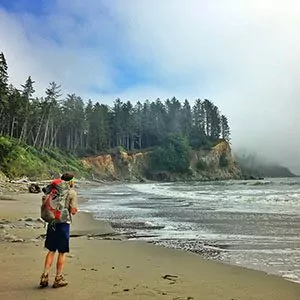
Backpacking in Olympic National Park is ideal in the spring as the weather gets warmer and melts any snow that may be on the trail. There are countless trails that will take you past waterfalls and rushing rivers, and through fields of wildflowers. Check out the park’s backcountry trail map to see which campsite will be best strung together for your next adventure! Take a look at our recommendations for the best backpacking trails in Olympic National Park. Below are our favorite areas for springtime backpacking:
1. HOH RIVER
- Trailhead: Hoh River Trail
- Distance: 37 miles
- Days to complete: 4-5
Backpacking through the Hoh Rainforest is nearly perfect in the spring. The rainforest can experience up to 140 inches of rain throughout the year—most of that rain occurring from November through April. Since there is so much rain over the winter, it makes traveling through the rainforest especially magical in the spring—the tree canopy is dense with old-growth, mosses and ferns cover whatever surface they can find, colorful wildflowers speckle the meadows, and the Hoh River is raging. There are many wilderness campsites along the Hoh River, ranging in distance from 3 miles (Mt. Tom Creek) to 17.4 miles (Blue Glacier at Mount Olympus). The first 10 miles of the trail are relatively flat, gaining only about 350 feet over all 10 miles; but once you reach Olympus Ranger Station, the trail starts to gain serious elevation as it climbs up the side of Mount Olympus.
Let an experienced guide lead you up to Blue Glacier on a 5-day, Hoh River Traverse guided backpacking trip. With all the appropriate gear and delicious backcountry meals provided, you can rest easy knowing that you are in good hands, as your safety is the company’s main priority.
2. ENCHANTED VALLEY
- Trailhead: Graves Creek Trail
- Distance: 26 miles
- Days to complete: 4
Backpacking to Enchanted Valley is world-class—named Enchanted Valley for a reason, as its thick, fern-covered rainforest is full of life and wisdom, enchanting all who travel through. This area is called the “Valley of 10,000 Waterfalls”, so it is extraordinary in the spring when the waterfalls are at their peak flow. The trail takes you through dense, old-growth forest, scattered with waterfalls, to wide-open views, colored with wildflowers; and the elevation gain is very moderate, letting you enjoy the scenery without your legs or lungs screaming for a break. There are many backcountry campsites along the Quinault River—O’Neill Creek, at 6.7 miles, and finally Enchanted Valley, at 13.2 miles. Highlights along the route include the wild Quinault River, Chimney Peak, Quinault Rainforest, and Anderson Glacier.
3. SEVEN LAKES BASIN
- Trailhead: Sol Duc Trailhead
- Distance: 18 miles
- Days to complete: 3
This 19-mile loop trail is perfect for a three-day backpacking trip. Starting in the lush rainforest, the trail winds through the old-growth before making its way up to the subalpine. Although its name suggests otherwise, there are actually eight lakes scattered throughout the area. The trail is fantastic in the spring because the panoramic vistas are teeming with life—wildflowers dominate the scene, elk and their young are common, and Sol Duc Falls is cascading over the rocks. Highlights of the trail include dramatic views of Mount Olympus, the Seven Lakes Basin, the chance to summit Bogachiel Peak, Heart Lake, and Sol Duc River.
Join a Guided Hiking Adventure
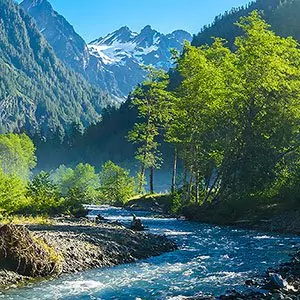
Olympic National Park is home to some of the most epic and amazing hiking vacations in the world. Wildland Trekking offers trips with the best of Olympic: the coast, the mountains, wildlife, solitude, adventure, and fascinating natural and cultural interpretation. Guided Olympic National Park treks are all-inclusive which covers permits, local transportation (excluded on certain tours), meals, equipment, safety systems, and professional hiking/wilderness guides; all of which allow visitors to maximize their time in Olympic and focus entirely on enjoying the Park.
OLYMPIC ADVENTURE TOURS
- GUIDED BACKPACKING ADVENTURES: these are for people interested in an authentic Olympic National Park adventure away from the roads and crowds.
- INN-BASED PACKAGES: these tours are all-inclusive packages with lodging, amazing daily hikes, expert guides, meals, transportation, and more!
- CAMPING-BASED HIKING PACKAGES: camping-based hiking packages provide all-around hiking experiences of the Olympic Coast on wonderful outdoor vacations.
- DAY HIKE TOURS: maximize your day in Olympic National Park on a fully guided, award-winning hiking tour on one of the Park’s best trails.





